Forest Rowan - extremely useful plant. And the honey plant, and its wood is beautiful, and feeds the birds in winter, and it is also good for itself.
One misfortune: its fruits, although healing, are bitter.. Because they are considered of little value. But this is if you take a dick, rowan ordinary.
Varietal is another matter.. About her and speech.
Table of contents
How to understand the mountain ash?
Our common, ubiquitous red rowan belongs to the large botanical genus Sorbus. In turn, almost all modern cultivars of this plant originate from this plant.
Or rather, from its two varietal-type species: Moravian (Central Europe) and nevezhinskoy (Eastern Europe).
Moravian mountain ash discovered in the Czech Republic in the XIX century and named after the region where it was found - Moravia. Its sweet fruits, with a diameter of 1 cm, made this variety interesting for breeders.
For example, varieties of Edulis, Bissnery and Concentrate originated from it.
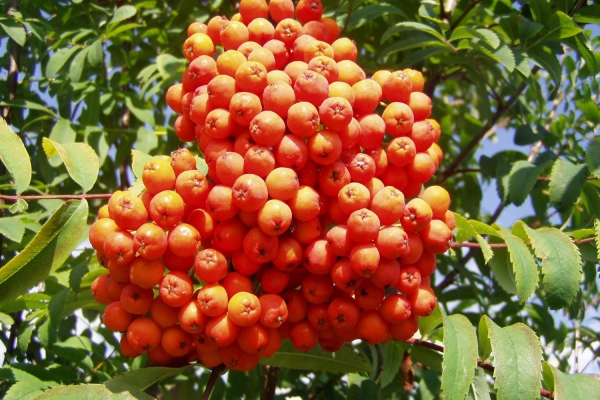
Nevezhinsky clone was also found by chance - in a forest near the village of Nevezhino, Vladimir region. Sweet, completely without bitterness, the fruits conquered the local peasants, who quickly realized to plant this rowan and sell seedlings to neighbors.
And this also happened in the XIX century. So almost simultaneously in two ends of Europe, nature presented man with sweet rowan instead of bitter.
Sometimes nevezhinskuyu mountain ash is called "Nezhin". The vintner Fedor Smirnov confused everyone, who used to sell tincture of its fruit in the old days. Not wanting to reveal the secrets of the recipe to competitors, he specifically threw out one syllable and called his product “Nezhinskaya”.
Ivan Vladimirovich Michurin was very interested in breeding varietal rowan trees. Many of the varieties created by him to date have either been lost, or they have been overpowered and have lost their original attributes, or are only kept in scientific collections. But those that have been preserved often become the basis for modern selection work.
Titanium
This variety is one of the surviving Michurin creations.. It was created by the complex crossing of a mountain ash, a pear and a red-leafed apple tree.
Its characteristics:
- Srednerosloy tree (up to 5 meters) with a rounded sparse crown. Shoots are straight, the color of the bark is dull brown.
- The leaves are glossy, dark green.
- Inflorescence-shields of medium diameter, the color of the petals is white.
- The fruits are slightly ribbed, rounded, weighing 1.2 grams. The skin is dark red, waxish. The flesh is yellow, sweet-sour, tart. The use is universal.
Grade Titan frost and drought-resistant, not affected by disease.
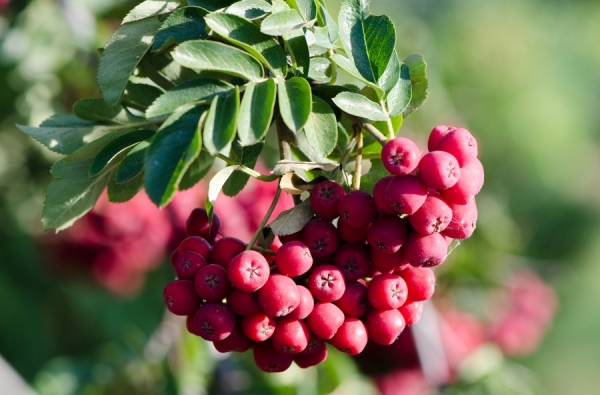
| The chemical composition of the fruit | |
| Sugar | 10,2% |
| Organic acids | 1,4% |
| Vitamin C | 33 mg / 100 g |
| Dry matter | 20% |
Bead
Variety created Candidate of Agricultural Sciences Tatiana Kirillovna Poplavskaya. Fanatically devoted to science, in the 70s of the 20th century she was actively engaged in the search for and restoration of lost Michurin varieties of mountain ash.
Characteristics and description of the variety:
- A plant of restrained growth, 3 meters high. Shoots are gray-brown, straight. Fruiting begins, according to various sources, at 3 or 5 years of age.
- Leaves are light green, gear.
- The inflorescences are large, with white flowers.
- Fruits of the correct rounded shape, with a red skin, weighing 1,2-1,9 grams. The flesh is cream-colored, with a hint of cranberry flavor, but without a strong acid. Purpose is universal. Ripen early, by the end of August.
Especially valuable advantages of a grade - high resistance to extreme frosts, drought, diseases. Productivity is high.

| The chemical composition of the fruit | |
| Sugar | 10% |
| Organic acids | 2,2% |
| Vitamin C | 67 mg / 100 g |
| Carotene | 9 mg / 100 g |
| Dry matter | 25% |
Liqueur Michurina
One of the Michurin varieties, lost and restored. He has a lot in common with one of his “parents” - black chokeberry.
Characteristics of a garden rowan variety:
- Medium-sized plant, about 5 meters, with sparse oval crown. Sometimes found in shrub form. It gives strong annual growths (up to 30 cm).
- The leaves are dark green, alternate, pinnate.
- Beautiful dense inflorescences with shield diameter 10 cm. The color of the petals is white-pink.
- Fruits are dark purple, almost black, weighing 1 g, ripen in September, stored for a month. The taste resembles a black chokeberry - sweet, slightly astringent. Purpose - for the manufacture of liqueur-type wines, preserves.
Grade advantages: high winter hardiness and moderate drought resistance. Disadvantage: fruits may be affected by rot.

| The chemical composition of the fruit | |
| Sugar | 10,8% |
| Organic acids | 1,3% |
| Vitamin C | 15 mg / 100 g |
| Carotene | 2 mg / 100 g |
| Cellulose | 2.7 g / 100 g |
Ruby
Also lost was the Michurin variety, but found,multiplied and transferred to the varietal testing of TK Poplavskaya. Like all old Michurin forms, this species of mountain ash has a slight astringency in taste.
Its characteristics:
- A low tree, 3 meters in height, with a drooping crown. Skeletal branches are located almost at a right angle, the shoots are straight, with light brown covers.
- The leaves are light green, with a finely serrated margin and a pubescent stem.
- Scuteine narrow, flowers small, pinkish-white.
- Fruits are rounded-flattened, weighing 1.3 g. The skin is ruby-colored, the flesh is yellow. The taste is sweet and sour, a little tart. The purpose of the fruit is to be processed into juices, jellies, wines, liqueurs, jelly. Suitable for drying.
To low temperatures, the plant is stable.
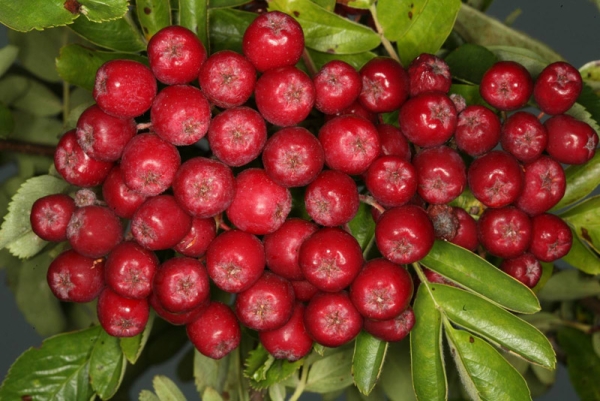
| The chemical composition of the fruit | |
| Sugar | 12,4% |
| Organic acids | 1,3% |
| Vitamin C | 21 mg / 100 g |
| Anthocyanins | 948 mg / 100 g |
Scarlet large
A variety bred by the Central Genetic Laboratory. Michurin (today the Institute of Genetics and Selection of Fruit Plants).An interesting, very showy plant, with really large fruits for the red apple fruit.
Characteristics of the variety:
- The height of the tree is 5 meters. Crohn middle density, broad-pyramidal shape. Weakly pubescent straight shoots with gray-brown bark and a variety of large lentils.
- The leaves are dark green, with shirokolantsetovidnymi plates, shiny.
- Wide shields with a large number of flowers.
- Fruits from 1.7 to 2.5 grams, slightly ribbed, juicy. Scarlet skin, spicy taste, slightly more acidic than other varieties, without bitterness. Appointment table and technical.
The variety is able to tolerate extreme frosts down to -50⁰С. Resistant to diseases and pests.
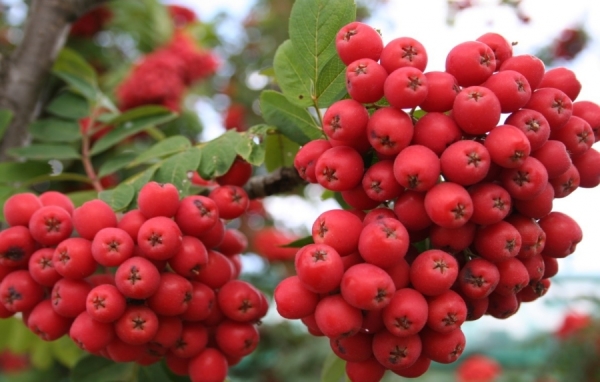
| The chemical composition of the fruit | |
| Sugar | 8,4% |
| Organic acids | 1,9% |
| Vitamin C | 21 mg / 100 g |
| Anthocyanins | 625 mg / 100 g |
White, yellow and orange ornamental varieties
In addition to the usual for the eyes of red and black ash trees, the efforts of breeders bred varieties with yellow, orange and even white fruits, able to decorate any garden.
For example, Yellow variety with thin flexible branches, which at a bountiful harvest lean to the ground.From its fruits are obtained mountain ash kvasses, original fillings for pies, jams.
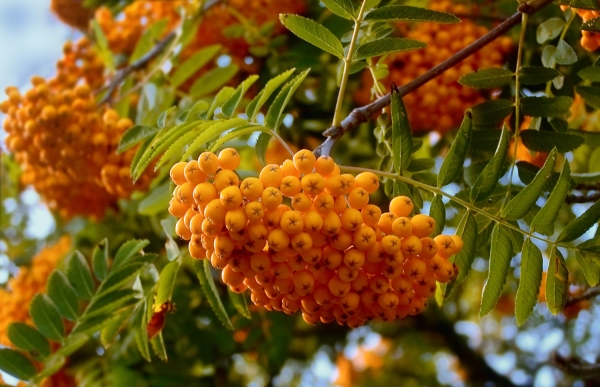
From orange fruit is very decorative Spark grade - one of the most heat-resistant and drought-resistant. As it ripens, it changes the color of the apples from yellow to fiery orange.
Rowan Daughter Kubov - a new variety, derived by spontaneous hybridization of the nevezhinskaya Kubova. The fruits of this tree also have a bright orange color in the ripeness phase, and their taste is juicy, bright, sour-sweet, without a hint of bitterness or astringency.
Productivity varieties Daughter Kubov phenomenal - up to 90 kg from one tree.
You may be interested in our publications:
Kubov itself also has orange fruits, but the yield is not so high. Cubic - a derivative form of nevezhinskoy rowan, created by popular selection. Her apples are slightly elongated, pentahedral, with a very pleasant taste.
But white-fruited ryabinki, unfortunately, is not suitable for food. For example, the varieties Kena or White Swan (White Swan) are very bitter fruits. However, their compactness and high ornamentation allows you to create an interesting play of colors among other rowan trees.
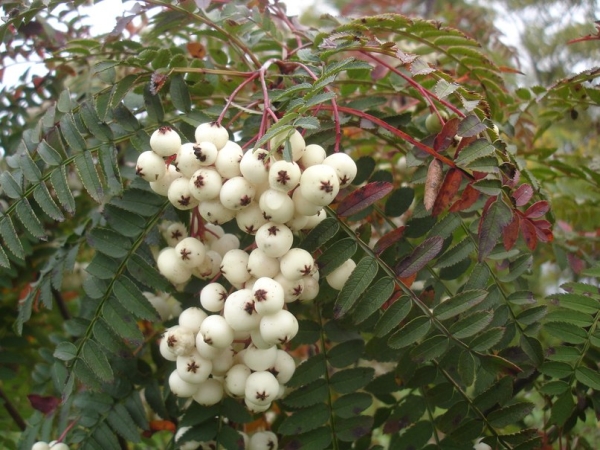
By combining in plantings, for example, a high Scarlet large, tender Yellow and miniature White Swan, you can get a combination of good and beauty.
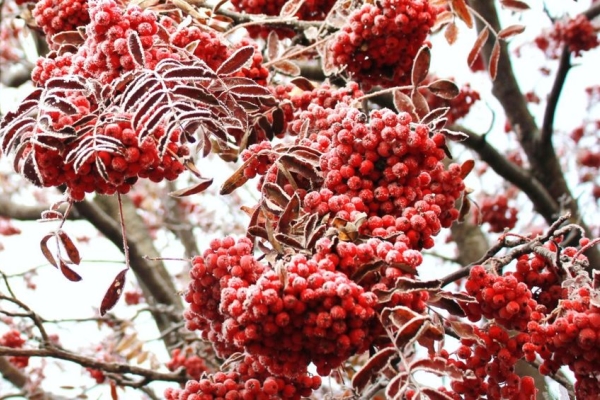
I am interested in a variety of rowan Kene or White Swan (White Swan).
Tell me where to buy it, and it will grow in the Leningrad region?